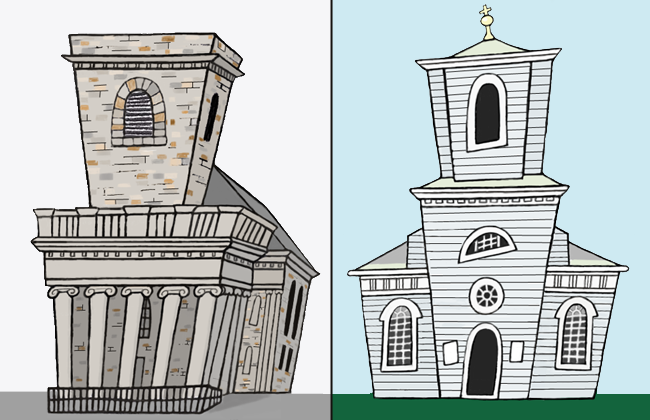RICHARD S. DARGAN | Architecture
King's Chapel (left), Christ Church (right) |
|||||||
|
Date: 1754; 1760 Given the strong anti-British sentiment of 1770s Boston and Cambridge, it's something of a miracle that the cities' pre-Revolutionary Anglican churches survive today, looking much as they did in colonial times. Both churches were the work of British-born Peter Harrison (1711-1775). Harrison conceived King's Chapel in downtown Boston as a modestly-scaled version of St Martin-in-the-Fields, James Gibbs' 1720s London masterpiece. The chapel consists of a tower and colonnade affixed to the front of a two-story hipped roof building with four-foot-thick walls of dark Quincy granite. The north and south walls have arched windows while the altar end features a Palladian window. There are galleries, or balconies, on three sides of the interior. King's Chapel was built around a small wooden church that previously hosted the congregation; workers tossed pieces of the latter out of the chapel windows as they dismantled it. The wooden Ionic colonnade, topped by a balustrade rather than the pediment seen in Gibbs' work, was added around the tower in 1786 from Harrison's design. An elaborate steeple planned to crown the tower was never built due to a lack of funds. Colonists tolerated King's Chapel after the Revolution, although they referred to it as the Stone Chapel. Today, it stands in the shadows of several much taller buildings on Tremont Street near the Common. A few years after King's Chapel was built, Harrison's exquisite Christ Church was erected across the river in Cambridge near Harvard University. The church made it easier for people from Cambridge and surrounding locales to get to services on Sunday. With its square tower at the entrance and arched windows, it bears a passing resemblance to King's Chapel. The congregation did not have the budget to build in stone, so Harrison employed wooden accents molded to look like stone, such as in the Doric frieze, with its triglyphs and metopes, and the rounded arches over the window frames. Additional decorative elements include a modillioned cornice between the tower and the belfry and a finial on the bell tower. The body of the church has a hipped roof, with a higher roof over the nave. The church served as barracks during Revolution and then fell into a period of neglect before restoration efforts began in the 1820s. It was enlarged by two bays in 1853, and renovated in the 1940s and again in 2011. It's the oldest church building in Cambridge. George Washington and Teddy Roosevelt attended services at it, and in 1967 Martin Luther King, Jr., delivered a speech against the Vietnam War from the church pulpit. Peter Harrison is widely considered among the best gentlemen-architects of Colonial America. He designed several other buildings that still stand today, including the Touro Synagogue in Newport, R.I. After the Tory-sympathizing Harrison died in 1775 in New Haven, Conn., an anti-British mob trashed his home and burned many of his drawings and papers. |
||||||
